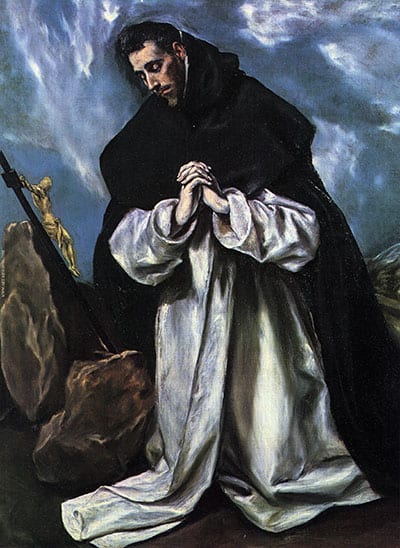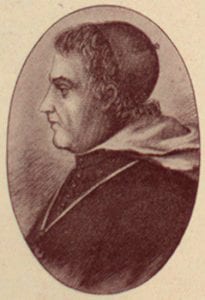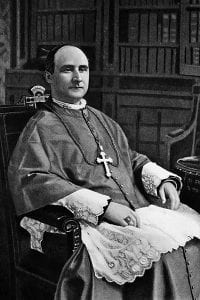The Roots of the Dominican Teaching Apostolates
Much of the material used in this story was drawn from “The Origins and Early History of Providence College Through 1947,” the dissertation of the late Dr. Donna T. McCaffrey, former PC associate professor of history, which was published in 1985.
Standing in the limestone pulpit sequestered below the portal arch of the new building on Sunday afternoon, May 25, 1919, Right Reverend Thomas J. Shahan, D.D., then president of Catholic University, addressed a gathered crowd. Prelates, bishops, clergy, and thousands of Rhode Island’s Catholic laity were joined by civic leaders from the city of Providence and the state of Rhode Island to celebrate the dedication of the French Gothic edifice, Harkins Hall – the first building of the embryonic Providence College.
Handsomely captivating in appearance, Father Shahan acclaimed in a stentorian voice, “the Catholic people of Providence and vicinity are fortunate, indeed, in the selection of the Fathers of St. Dominic, as the teachers for this new college.” Herein, lay the fundamental origin of Providence College.

The history of Providence College began more than 775 years ago. Dominic Guzman, a Spanish nobleman, embraced poverty and had an idea. He wanted to establish an order “for preaching and salvation of souls.” He petitioned the papacy, and on December 22, 1216, Pope Honorius III gave his support to Dominic’s idea and declared the Order of Preachers “inviolable for all time to come.” In his Bull of 1216, Pope Honorius prophesied that Dominic’s brethren would be “champions of the faith and true light of the world.”
Dominic immediately sent his sons to study at the great European universities. Where they went to study, they remained to teach. St. Thomas Aquinas took Dominic’s idea and affirmed that teaching was one of the essential objects of the Order and in his Apologia for Religious Orders argued the appropriateness of the teaching apostolate for religious. For the next six centuries the Dominicans held the teaching chairs of Scripture and Theology at nearly all the major European universities – from Oxford to Lyons, Paris, Bologna, Bordeux, Cologne, Milan, and Valencia. By the nineteenth century a host of Dominican men and women had carried on the Dominican teaching tradition throughout Europe. The idea then traversed the Atlantic Ocean.
In Europe at the time of the persecution of Catholics in England, the Napoleonic purges in Europe, American-born Dominican Father Edward Dominic Fenwick had an idea – to bring the Dominican Order to the newly formed United States. Fenwick wanted to begin his American foundation with a college. He came home in November 1804 ready to found a college in Maryland on the property his family owned. Yet, first, U.S. Bishop John Carroll was in desperate need of missionaries for the dangerous wild frontier of Kentucky. Sacrificing his collegiate idea to the pressing needs of the infant U.S., Fenwick and his small band of three traveled west, by foot or on horseback, to bring the faith to the pioneers. For the next sixty years the persistent theme of the Dominican college apostolate was a dominant influence in Fenwick’s Province of Saint Joseph. Before the Civil War, three Dominican colleges were opened: in 1805 Saint Thomas College, Kentucky; in 1841 Saint Joseph’s Studium, Ohio; and in 1846 Sinsinawa Mound College, Wisconsin. Three U.S. bishops, scores of future missionary priests, and Jefferson Davis became alumni. Unfortunately in the mid-nineteenth century, the Dominican Constitutional interpretation of the new Master General, Alexander Jandel, O.P. emphasized the consensual contemplative Dominican life over the active Dominican teaching apostolate. All three Dominican Colleges closed before or because of the Civil War, were not reopened. Although dormant for the next forty years, the Fenwick ideal of a Dominican teaching apostolate was strongly entrenched in the American Order of Preachers. They were ready to respond to the call of the Bishop of Providence, Rhode Island.
Irish Bostonian Mathew Harkins went as a young priest in 1884 to the Third Plenary Council. The American Catholic Church was in crisis, faced with an overwhelming influx if Catholic immigrants, beset by a vicious nativist anti-Catholic movement, and persecuted by strong prejudice ingrained in a predominantly Protestant country. Harkins listened at the Council of Bishops to the plea of Bishop John Lancaster Spalding:
We live in the midst of millions who still bear the yoke of inherited prejudices and who because for three hundred years real cultivation of mind was denied to Catholics who spoke English, conclude that Protestantism is the source of enlightenment and the [Catholic] Church the Mother of ignorance.
Young Harkins caught the fire and passion of Spalding’s appeal:
To be intellectually the equals of others, we Catholics must have with them equal advantage of education, and so long as we look rather to the multiplying of schools and seminaries than to the creation of a real university our progress will be slow and uncertain, because a university is the great ordinary means to the best cultivation of the mind.
Matthew Harkins absorbed and made these ideas his own.
On April 14, 1887, forty-one-year-old Matthew Harkins was consecrated Bishop of Providence. Amongst his many labors, Harkins quickly began a gargantuan educational building program in his new diocese. From the onset, he enlisted the support of the diocesan clergy and consistently pressed priests and pastors to educate the young of the Providence Diocese. In the late 1880s, twenty-odd years after the close of the Dominican colleges, Bishop Harkins envisioned a Catholic college as the capstone of his diocesan educational program. Long-time friend, Bishop Louis Walsh of Portland, wrote in 1921, “I had many talks during several years with the late Bishop Harkins on the erection of a Diocesan college in Providence and found the idea strongly entrenched in his mind, almost from the beginning of his Episcopate.” Bishop Harkins “was particularly anxious to see his idea and plan realized.”
In the first twenty years of his episcopacy, Harkins’ dream took various forms. Jesuits invited by his predecessor, Bishop Hendricken, to found a college departed unsuccessfully in January 1899. Much to Harkins’ “regret,” this closed one avenue. In 1902, a secondary school was entrusted to the Christian Brothers. LaSalle Academy was legally incorporated with a special clause granting the institution the right to confer degrees normally associated with a college institution. The student population growth on the high school level prevented collegiate expansion. The Bishop waited implementation of his dream. In 1910 the “time was ripe” for accomplishing the “idea strongly entrenched in his mind.”
In his search for a religious order to staff the college, the Bishop turned to an entirely new sector. As an active committee worker for The Catholic University’s Board of Trustees, Bishop Harkins had contact with one of the Church’s oldest teaching orders, the Dominicans. On August 20, 1905, the Dominican House of Studies, incorporated on December 18, 1902, as the College of the Immaculate Conception, opened on Bunker Hill Road, now Michigan Avenue, Washington, D.C. Here the American Dominicans educated aspirants to the Province of Saint Joseph. Many Dominicans also engaged in “study at The Catholic University just across the street.” Victor O’Daniel, O.P., long-term historian of the Province of Saint Joseph, forcefully attests that “whenever Bishop Matthew Harkins of Providence, Rhode Island came to The Catholic University, he paid a visit to the House of Studies.” However, not until November 1910 does Harkins mention any visits in his otherwise precise diary. That “dinner” visit was preceded by contact with John Dominic Maria van den Wildenberg, O.P. Earlier in the summer 1910, Bishop Harkins’ quest for a college foundation was augmented by the association of the Bishop and this son of the former Belgian Consul General at Chicago. Assigned to the Dominican mission (preaching) band in 1906, Father van den Wildenberg was “taking Father Sullivan’s place” at Saint Agnes Parish in Rhode Island for “two of three weeks” in July 1910. The Bishop struck up a comfortable relationship with the Dominican, recreating at least one day at Narragansett Beach.
Some conversation about a college must have ensued. Ten days later on August 3, 1910, Bishop Harkins met formally with both Father van den Wildenberg and the Dominican Provincial, Matthew Leo Heagen, O.P. The three “spoke about [a] foundation.” As a preliminary to the founding of a college, by October 1910, serious discussion between the Bishop and van den Wildenberg arranged “property matters” for a “parish to be taken by [the] Dominicans” in Harkins’ Diocese.
The Belgian Dominican met again with the Bishop on November14, 1901, and arranged a meeting for Harkins at the “Dominican House of Studies.” In Washington the next day, Harkins “arranged about [the] foundation” and “took dinner” with the Dominicans. Although the content of the conversations was unrecorded, there is no doubt that by November 24, 1910, Matthew Leo Heagen, O.P. “placed before the [Provincial] Council a petition from Bishop Matthew Harkins of Providence [inviting the Dominicans] to undertake the establishment of a new college in the City of Providence, Rhode Island.” The invitation was extended; the Bishop had chosen the Dominicans for the college of his long-time hope. In turn, the Dominicans, heirs of a seven-century teaching apostolate, were interested in this new undertaking.
The Provincial wrote the Master General Hyacinthe Cormier, O.P., on January 7, 1911. He reported that the Provincial Council had accepted the Bishop’s offer to renew the collegiate apostolate. “The Fathers voted unanimously that we petition the Master General and the Holy See to make this foundation.” They also asked “permission to borrow $150,000 to build a church and rectory in Providence.”
Permission for the parish work was forthcoming. In regard to the establishment of the college, Victor O’Daniel was in attendance when the “offer was heartily accepted by the Provincial and his council.” O’Daniel recalled that Father Heagen and the councilors “requested the Bishop to wait until [the Dominicans] had more priests for the purpose.” Dominican Father James B. Walker, a reliable source for that period in provincial history, later noted that:
The Council of the Province unanimously approved of accepting the offer, but requested the postponement of making the foundation for a few years so than an adequate staff of professors could be provided. The Bishop graciously consented, predicting that the college, when founded, would be a source of great good, not only for his diocese but also for the order.
Later that year, on September 22, 1911, Bishop Harkins “met the Master General, Fr. Cormier,” in Rome “at the Dominican House.” What transpired is unknown. However, although permission had yet to be received from Rome, Bishop Harkins for all practical purposes had found the religious order to staff his college. At 9:30 a.m., November 13, 1911, Bishop Harkins held a “meeting of [the] new Corporation” called “Dominican Fathers School Corporation.” From February through April 1912, the Bishop met several times with Fathers Heagen and van den Wildenberg.
In anticipation of the Rhode Island arrival of the Dominicans, the Bishop continued pragmatic steps to convert his dream into reality. By December 1911 arrangements were made to purchase acreage on the east side of River Avenue in northwest Providence on had been the Bradley Estate. Twelve and a half acres including a two-and-a-half story house with outbuildings were secured. The owner of the land preferred to sell her property to the diocese rather that have it subdivided into house lots. In 1913 additional land was sought and contiguous acreage comprising approximately six and a half acres was purchased by Bishop Harkins.
Meanwhile, the permission sought from the Master General by the American Province was not forthcoming. “Permission to accept the college [apostolate] was presumably refused, although the documents are silent on the matter. “ “Father Cormier, refused permission – probably because without any explicit authority for it in the Dominican Constitution, he had given the Americans permission to institute” a school in Columbus, Ohio, for the preparation of “young men for the priesthood.” The Master General’s “conscience was troubled.”
Without Roman permission, Father Heagen was unable to pursue the matter. Harkins’ hope for an educational capstone and Fenwick’s century-old goal of an American Dominican college might well have ended here. However, two significant personalities moved to center stage. On October 11, 1913, James Raymond Meagher, O.P., was elected Provincial-successor of Heagen, and in August 1916 Dutch-born Louis Theissling, O.P., was elected Master General to succeed the ailing Father Cormier.
For at least two years the college idea lay dormant in the Bishop’s house. The new Provincial Meagher later recalled, “It was only by accident that I heard about” the Bishop’s offer, as Father “Heagen never mentioned it.” Father Meagher, however, “saw a good prospect in such an idea and approached the Bishop,” on December 15, 1915. Meagher later recalled the Bishop’s surprising first remark. “Why, I thought the Dominicans had given up all idea of doing anything regarding the college?”
Far from abandoning the idea, young Raymond Meagher shared the Bishop’s broad vision. He too was a builder and accomplisher. Thus, by 1915 Harkins found a man equally strong in devotion to Catholic education. Father Raymond Meagher, Irish Bostonian, was committed to the Dominican seven-hundred-year-old tradition and to Fenwick’s American dream.








